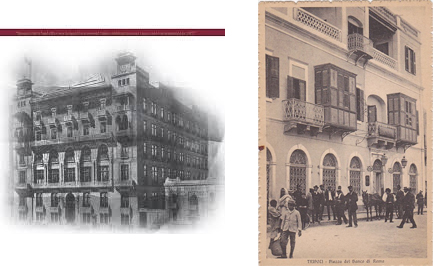
This year marks a century since the Vatican bankers, led by the Pacelli family, whose most famous member Eugenio, who worked in Tripoli and Cairo, became Pope Pius XII. They laid the foundation for a common idea between an Egyptian and a Vatican bank and, as significant, between an Egyptian party of religious inspiration, but profoundly secular, and a political movement that would later become the Italian Christian Democrats. (DC).
In that intervening hundred years, everything has changed. This bank, Banque Misr, now belongs to the Egyptian State; this party, the Muslim Brotherhood, has been persecuted, its members tortured and killed and has become more radicalized. The Vatican itself has changed its stance on Egypt and the Arab world several times but to discover this history it is necessary to understand this fascinating parallel between Italy and Egypt in the early 20th century and to understand its continuing consequences.
We therefore begin this narrative at the moment when nationalist Islam and the papacy are at opposite poles and are taking the first very careful steps towards rapprochement. Cardinal Jean-Louis Tauran, President of the Pontifical Council for Interreligious Dialogue, was the Vatican diplomat who worked for a quarter of a century, under three popes, John Paul II, Benedict XVI and Francis I, to develop cooperation between the Vatican and COREIS, the Islamic Religious Community of Italy[1]. (Touran died on July 5, 2018)
Outcomes of his diplomacy began before Touran’s death, with a historic meeting on religious issues between John Paul II and Ali Abd al-Rahman al-Hashemi, Councilor of the United Arab Emirates and staff member of the leader Mohammed bin Zayed Al-Nahyan[2], at an annual event at Rimini, the Meeting for Friendship among Peoples.[3]
The conspiracy against Pope Francis
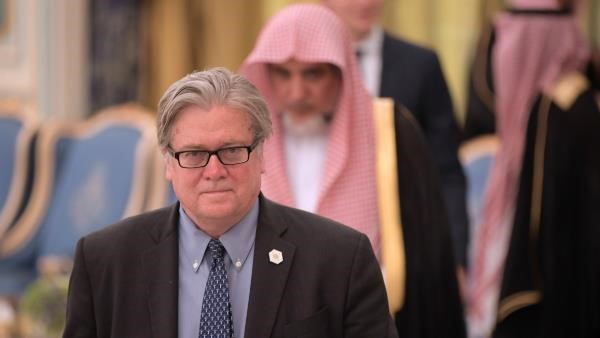
Steve Bannon in Abu Dhabi
This meeting in 2007 marked the beginning of a path that, after decades of hostile silence, enabled diplomatic relations between the United Arab Emirates and the Vatican to be established and led to the appointment of Cardinal Paul Hinder as Vicar Apostolic of Abu Dhabi[4]. This proved to be a constructive move which further relaxed relations and culminated in the meeting between Pope Francis I and Mohammed bin Zayed Al Nahyan in Rome in 2016[5] and then in Abu Dhabi in February 2019[6].
Nevertheless, Paul Hinder takes an ambivalent position both on the Muslim Brotherhood and regarding the bitter war of the pro-Saudi government in Cairo, Riyadh and the Emirates against this political movement: “When the Muslim Brotherhood spread from Egypt to other countries years ago, they were welcomed with open arms (…). But the idyll did not last long, and some Arab states have responded with tight and stringent controls or displacement“.[7]
This is not a view that the Vice President of COREIS, Yahya Pallavicini[8],wants to analyze[9]; COREIS does not allow itself to be involved in the internal struggles of Islam, especially those related to the Muslim Brotherhood[10]. According to Pallavicini, this is the only possible way, since COREIS represents all Muslims, not just one faction[11].
There are forces, even within the Christian world, which oppose the rapprochement between Christian and Muslim churches and accuse Pope Francis of heresy. They want his resignation on behalf of chauvinism and ethnic, religious, and political racism[12]. These are the same types of forces that have traction with the violent and undemocratic extreme right-wing political movements: the ones associated with the Saudi and Emirati monarchies in Italy, as in several Middle East countries; in the United States and Asia – Donald Trump, Steve Bannon and the Ku Klux Klan; and in Europe, Matteo Salvini in Italy, Marine Le Pen in France, Alexander Gauland and Christian Lueth in Germany, Norberto Pico in Spain, Nikolaos Michaloliakos in Greece, Jaroslaw Kaczinsky in Poland, Viktor Orban in Hungary.[13]
Those who accuse Pope Bergoglio of supporting terrorism and political heresy and who are in favor of the monarchies in Islamic countries do not know about the hundred years of cooperation between the Vatican and the Islamic Brotherhood. Or, indeed, that the Muslim Brotherhood, a secular party with strong roots in Islam, was modeled on Don Luigi Sturzo’s Italian Popular Party[14], which then became the Christian Democrats and led democratic Italy for over sixty years. The Muslim Brotherhood, like the Vatican, sympathizes with the movements associated with the outbreak of the Arab Spring, because all over North Africa, from Tunisia to Libya and Egypt, all groups related to the Muslim Brotherhood tried to enable conditions for a similar party to the Italian DC; worldly, but strongly religious[15].
The birth of the Misr Bank
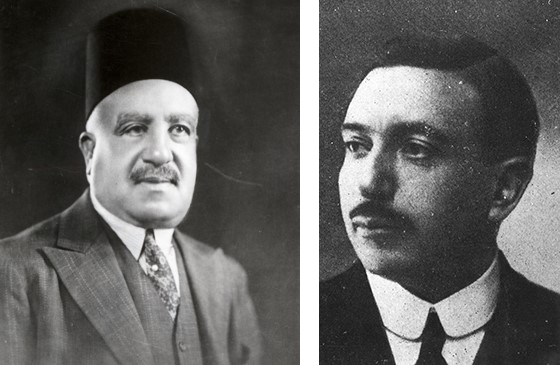
Tal’at Harb and Alberto Beneduce
It was also a century in which the Egyptians chose the Italian Institute for Industrial Reconstruction (IRI)[16] as a model to start their own economy[17], free from the English yoke. The institute emerged from the ideas of the economist Alberto Beneduce, who had been fighting in Parliament for the establishment of a bank in the service of the industrial revolution since 1911[18]. Long before he founded IRI, Beneduce founded CREDIOP (1919), a bank that sought investment from enlightened entrepreneurs whose profits, multiplied by financial speculation, subsidized national industrial revitalization[19].
Banque Misr[20] is the result of this attempt, which was structured exactly like CREDIOP. Banque Misr was the first bank of pure Egyptian capital and was rejected by the British colonial power which at all costs wanted to avoid strong economic concentrations between Egyptians that could question London’s primacy[21]. It was supported and protected by the German government[22] however, over a decade before National Socialism took power in Berlin,[23] as the Germans fought against the British Empire for the commercial supremacy in the Mediterranean[24].
This purely Egyptian bank was the driving force that founded and financially supported the birth of Egyptian transport companies, shipping companies in partnership with Banco di Roma[25], the building and food industry, the energy and textile industry, between 1920 and 1936[26]. For the wonderful building that houses the Banque Misr, and which was inaugurated in 1927, Tal’at Harb commissioned an Italian architect, Antonio Lasciac[27] from Gorizia, who spent the rest of his life in the Middle East, mostly commissioned by the Vatican, building churches and monuments.[28]
Later, as Beneduce was already working for the Mussolini government, he sent a young Banca Commerciale Italiana (COMIT) banker Paolo Grassi[29], to work with Egypt and Banque Misr to set up the COMIT branch in Cairo in 1921[30]. Grassi would later become one of the greatest economists in the history of Italy.
But the Vatican had already gone further in developing partnerships with Banque Misr. In 1912, the Banco di Roma, led by Ernesto Pacelli founded the Cines Seta Artificiale, the first large Italian artificial textile industry. Investment from the Banco di Roma between 1920 and 1936, working with the Misr Group’s industries[31], made Egypt one of the most important markets for the Italian textile industry (and vice versa)[32].
The economic conquest of Libya

Hassan Al-Banna and Luigi Sturzo
Everything has changed today. Banque Misr has been nationalized since 1960. After a troubled century, the bank employs around 14,500 people and has the largest portfolio among Egyptian banks, over 10 million customers[33], capital of around 15 billion EGP (USD 950 million)[34], sales (2018) of EGP 670 billion (USD 42 billion)[35], 159 holdings in banks, industries, trading companies, five branches in the United Arab Emirates and one each in France, Lebanon and Germany as well as representative offices in China and Russia and a global network of correspondents worldwide.[36]
However, there is one secret that has not yet been revealed. As the relationship between Egyptian nationalism and CREDIOP led by Beneduce was born, and during the Italian colonial adventure in Libya, the Vatican itself embarked on the path that leads to Cairo through the newborn Banco di Roma[37], whose majority stake at that time was in the hands of the Vatican and the Jewish community of Rome[38]. The bank, in consultation with the government led by Giovanni Giolitti[39], opened a branch in Tripoli. It was an alternative for local entrepreneurs against Turkey, which remained in occupation of Tripolitania[40], Cyrenaica and Fezzan.[41]
Under Benito Mussolini’s fascist government, the presence of the Banco di Roma in North Africa increased. After the inauguration of the Cairo branch, Ernesto Pacelli, banker for the Vatican and nephew of Pope Pius XII[42], gave new directions to customers in Egypt and Libya[43]. The bank did not support Mussolini’s allies in Egypt. The fascist leader supported Ahmad Hussein, the leader of the Misr Al-Fitat movement – a group of black shirts that fought under the flag of anti-Semitic principles, corporatism and extreme chauvinism, and whose positions are widely distant from those of the Banque Misr and the Muslim Brotherhood[44].
Nor did the Catholic Church support the then Egyptian majority party, the WAFD – Ḥizb al-Wafd al-Miṣrī – the delegation party, founded in 1919 to achieve the independence of Egypt during the Treaty negotiations in Locarno[45], because WAFD stood for the secularization of society and for opposition to all European religious and political forces[46].
The Vatican sought elsewhere and discovered Mohammed Tal’at Pasha Harb and his dream of an independent, worldly, yet religiously inspired Egypt, based on the collaboration between Muslims, Coptic Christians and Sephardic Jews, who invested in the nascent Banque Misr[47].
Harb took the idea of founding this bank from Italian and German bankers. The bank was founded with the financial contribution of six families of Egyptian landowners who have their origins in the province of Al-Minya[48], like many of the investors at Banco di Roma in Egypt[49], based on the guidelines set out by Tal’at Harb in his 1911 book: “Egypt’s Economic Solution and the Project for an Egyptian or National Bank“, which shows the way to liberation from the British colonial yoke.[50]
The end of the Italian colonial dream

Gamal Abd-el Nasser
Tal’at Harb’s thinking inspired many Egyptians, especially Hassan Al-Banna, who founded the Muslim Brotherhood in 1928[51], the movement that grew during the early years of the Banque Misr, and which supported it economically, politically, and with propaganda among Egyptian entrepreneurs[52]. This period ended when Gamal Abdel-Nasser came to power after the coup in 1952, with the consequence of the expulsion of the British military and the ban on the Brotherhood, whose leaders fled or were imprisoned in Egypt[53]. Until then, Banque Misr continued to be run by the heirs of Tal’at Harb, the friends of Hassan Al-Banna[54], the country’s main landowners, and those lay intellectuals who dreamed of an Egypt similar to Ataturk’s Turkey.[55]
Like General Abdel Fattah Al-Sisi, president of Egypt, and his friends in Riyadh and Dubai today, President Nasser had an official religious reason to oppose the Banque Misr; he accused the bank of being an institution that operates according to the rules of international finance and not according to Sharia law[56]. It is the same reason that General Al-Sisi claims, over 90 years after its founding, makes the Muslim Brotherhood (and the old Banque Misr leadership) guilty of heresy.[57]
Banque Misr was also the first bank in the Arab world to be accepted among the members of the Bank for International Settlements in Basel [58](BIS) at the end of the Second World War. In 1952, Saudi Arabia and its Arab Bank also joined, but only after the monarchy founded the SAMA Saudi Arabian Monetary Agency, which forces the Saudi credit system to adhere to the rules of international trade. Before World War II, the clearing of Egyptian banks was controlled and guaranteed by the Bank of England[59], and the official currency was the pound[60]. The Banco di Roma, which supported Banque Misr’s application for membership of BIS as early as 1936 and showed that Egypt was one of the few countries that could mint money with full gold reserves[61], had been a member of the BIS since 1930[62].
After the military defeat of World War II (1946), the Italians only managed to reopen the branch of the Banco di Roma in Tripoli[63], and the main headquarters of the Banco di Roma itself was led by Christian Democrats, following the decision of the first post-monarchist government. The bank was transferred to IRI due to the Vatican’s post-war financial difficulties, [64] although it maintained a very close relationship with the Vatican[65] and the Pacelli family (the family of Pope Pius XII)[66].
Its German equivalent, the Deutsche Orientbank, which belonged to Dresdner Bank[67], was headquartered in Istanbul, but due to the collapse of the global economy in 1929, it plunged into a liquidity crisis, came under the official[68] control of Turkish shareholders, which had to file for bankruptcy in 1946.[69]
Ahmed Al-Najjar and the Mit-Ghamr Bank
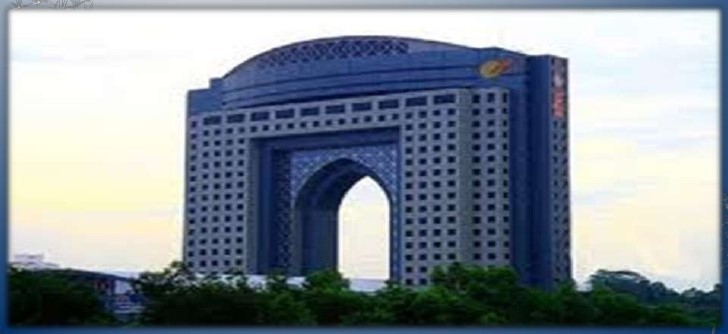
The HQ of Mit-Ghamr Bank in 1965
Cooperation between Banque Misr and Banco di Roma was restarted in 1975 as the bank founded Misr International Bank, shortly after Egypt opened to foreign capital investment. Banque Misr held 44% and Banco di Roma[70] held 7.375% of the shares, which increased to 10% of the capital[71] in the following years.
Despite Banque Misr nationalization by President Nasser, the connection between the bank and the Muslim Brotherhood remained very strong[72], especially thanks to Ahmed Al-Najjar and his Mit-Ghamr Bank[73], the prototype Islamic bank. Al-Najjar, who studied in Germany, combined his studies and work, after returning to Egypt, with the influence of the socio-economic thinking of the Muslim Brotherhood, born out of the Banque Misr and rejected and annulled by the Nasser regime. His Mit-Ghamr Bank was founded in 1963 and applies Sharia law[74], that is it does not pay dividends or interest, but grants interest-free loans, with the returns and profits structured in accordance with one of several Sharia compliant methodologies. [75].[76].
Al-Najjar founded Mit-Ghamr Bank in Ad Daqahliyah province because there was already a large and thriving aluminum production center there at the end of the First World War, consisting of about 20 small factories, producing more than 70 % of national demand[77]. However, in order to survive economically and ensure production, these factories employed up to 50,000 people, paying starvation wages. At least a third of the employees were children who were paid even less, and severe lung diseases such as fibrosis was rampant, facts that left the Egyptian authorities completely indifferent for a century[78].
Al-Najjar’s attempt worked[79]: the first bank in the world to use Sharia law made good money, guaranteed wages for employees from a dozen branches, paid Zaqat and granted over a quarter of its assets to what we now call microcredit[80], at that time a revolutionary concept that Al-Najjar had learned from the German savings banks. (These are called Casse Rurali in Italy[81].)
But Nasser did not support this model and nationalized Mit-Ghamr in 1967, renaming it Nasser Savings Bank and forcing Al-Najjar to emigrate to Turkey[82]. The branches of the surrounding villages were distributed among the four nationalized banks of Egypt (including Banque Misr), but in the following years they closed their doors. Al-Najjar saw an economic downturn in trade and industrial production in 1967, which had a serious impact on the bank; on the one hand, no profits were posted, on the other hand many customers were no longer able to repay the debt on a regular basis , even though these were without interest charges[83].
Although the production system is obviously out of date and almost all of these Mit-Ghamr aluminum factories are now facing insolvency, the Egyptian government decided in 2014 to refinance them because they are good for employment and social cohesion and therefore cannot be closed; it doesn’t matter at what price either in cash or health.[84]
The interreligious debate on bank interests
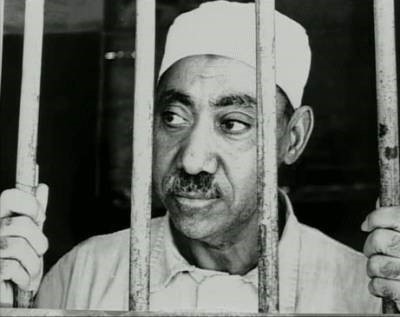
Sayyid Qutb shortly before his hanging
The Mit-Ghamr experiment was enthusiastically supported by the Muslim Brotherhood, which, according to economic history scholars, is the main reason why Nasser wanted to destroy this attempt[85]. However, the Vatican found the Mit-Ghamr Bank experiment admirable. Since the time of the French Revolution and even earlier, with the writings of Thomas Aquinas, the Catholic Church had condemned the birth and growth of the banking system and its interest on loans as a threat to the stability of feudalism and absolute monarchies, characteristics that are inextricably linked to the power of the Catholic Church.[86]
It was only in 1917, under the pressure of the Calvinists’ secessionist threats[87], that the Vatican admitted the legitimacy of charging interest[88]. In principle the Catholic Church had always fought against this type of profit, which explains its support of the Muslim Brotherhood and Sharia-supported rules.
After the election of Pope Francis, the Vatican reopened the internal debate on the lawfulness of interest rates and openly showed sympathy for the Sharia, prompting the International Monetary Fund (IMF) managing director Christine Lagarde to improve the position of the Vatican comments and accept their validity.
The position of the papacy is so clear[89] that the Vatican[90] publisher Marcianum Press prints the Italian version of the main Sharia[91] economic theory books and Giovanni Maria Vian, director of the official Vatican newspaper “L’Osservatore Romano“, has repeated and adhered to the financial principles of Sayyid Qutb[92], one of the ideological fathers of the Muslim Brotherhood and a major supporter of Tal’at Harb and Ahmed Al-Najjar’s[93] economic theses. Qutb was persecuted and hanged by President Nasser[94] in 1966.
Gamal Abdel Nasser’s hatred of Tal’at Harb and the Al Banna movement probably started in the cradle as he came from a poor Al Minya family and his mother’s family suffered under the economic yoke of the local families who founded Banque Misr[95]. From his youth, his pro-socialist and militaristic position had led him to hate Israel, as the oppressor of the Palestinians and illegal occupier of areas that Nasser considered Egyptian.
Nasser was also a bitter opponent of the papacy. The Vatican, at the time was under the papacy of John XXIII, who tried to bury the ambiguous positions of Pius XII concerning National Socialism and even tried to establish solid connections with the extremes of Jewish Zionism[96]. Abdul Rahman Azzam, Secretary General of the Arab League, accused the Pope in 1945 of never taking a clear position against the Jewish idea of creating a “Jewish symbolic State” in Israel, modeled on the Vatican City.[97]
But after the fall of Nasser, during the papacy of Paul VI and John Paul I, the Vatican showed equidistance from the two most extreme currents of contemporary Islam: the Wahhabis from Saudi Arabia, where Al Qaeda has its roots, and the Muslim Brotherhood, which, after the suppression and execution of Sayyid Qutb, proclaimed the correctness of jihad to avoid oppression of the Muslim religion[98].
The rapprochement
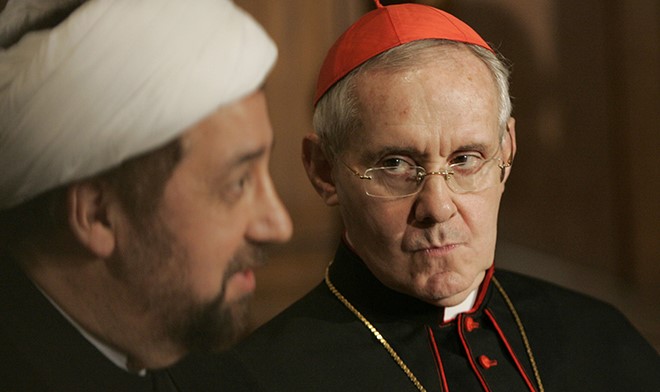
Cardinal Jean-Louis Tauran and Ayatollah Ahmad Iravani
In the years before the Arab Spring there had been an approach to the Moslem Brotherhood. In 2007 there was a very positive exchange of official messages[99], despite a gaffe by Benedict XVI, for which the Pope presented his apologies[100]. Just after Mohammed Morsi won the Egyptian elections in 2012 and the Muslim Brotherhood[101] party became the country’s democratic majority, Cardinal Michael Fitzgerald the Vatican ambassador to Cairo paid an official visit to Sohag, the Brotherhood’s base.
Unfortunately, the unrest in Egypt began immediately afterwards, and we cannot say whether the 37 burned Christian churches, as well as the Coptic massacres, were carried out by angry and uncontrolled mobs, by the fascist troops of Abdel Fattah Al-Sisi and his sponsors from Abu Dhabi and Riyadh or were committed by the Brotherhood. Mainly because of the bloody events in Egypt, relations with the Vatican were frozen until the election of Pope Francis I. [102]
The election of the new Pope sparked enthusiasm and hope in the Brotherhood[103]. but that enthusiasm is not shared by the Jesuits who today show more sympathy for Saudi Arabia and Egypt than the Arab Spring and the Brotherhood. Jesuit criticism of the pacificist tendency of Francis I[104] is so persistent that the new Pope, himself a Jesuit, replaced the Jesuit Father Federico Lombardi, who has dominated the political line of all the Vatican media for decades[105]. Then the phase of improved relationships began. It is still in its infancy but continues.[106]
The fact is that a circle has closed after a hundred years. The banking system, inspired by religious criteria, has returned to the starting point that the Pacelli family, the Banco di Roma, the first version of Banque Misr, Tal’at Harb, and the Pope and Brotherhood agreed. The financial system without Sharia rules has failed considerably, in that it does not defend society and humanity, but suppresses the weak and enriches those who were already rich and powerful. As for the political aspect, more than twenty years after the decline of Christian Democracy the weight of religious morality in politics cannot remain in the hands of right-wing populists, opportunists and monarchists who kiss the rosaries but commit atrocities.
Perhaps Christians need a new Luigi Sturzo in politics, and the Muslim Brotherhood could return to its origins in the thoughts of Hassan Al-Banna and the understanding that jihad does not liberate but only kills in arbitrary ways, often out of pure ethnic hatred or personal frustration. John Paul II has said it; the 21st century will be a great return to a sense of God and spirituality. As a staunch layperson, I hope this means a return to the positive values of religious teaching and not to the murderous folly of many who have used the various names of god to commit inhumane massacres for purely personal and political purposes over the past 2000 years.
[1] https://www.coreis.it/dialogo-interreligioso/notizia/ultimo-saluto-al-cardinale-jean-louis-tauran-protagonista-del-dialogo-tra-la-santa-sede-e-lislam-italiano-e-mondiale
[2] https://www.youtube.com/watch?v=XC8WLiebOB8
[3] https://www.coreis.it/dialogo-interreligioso/notizia/ultimo-saluto-al-cardinale-jean-louis-tauran-protagonista-del-dialogo-tra-la-santa-sede-e-lislam-italiano-e-mondiale ; https://web.archive.org/web/20100613025043/http://meetingrimini.org/default.asp?id=673&edizione=3923
[4] http://www.asianews.it/notizie-it/Relazioni-diplomatiche-tra-Santa-Sede-ed-Emirati-arabi-9423.html ; https://www.toscanaoggi.it/Toscana/SANTA-SEDE-ALLACCIATE-RELAZIONI-DIPLOMATICHE-CON-GLI-EMIRATI-ARABI-UNITI
[5] https://www.mei.edu/publications/pope-uae-and-muslim-brotherhood
[6] https://www.vaticannews.va/it/papa/news/2019-01/papa-francesco-abu-dhabi-videomessaggio.html
[7] http://www.30giorni.it/articoli_id_15285_l3.htm
[8] https://www.nuovaresistenza.org/2015/06/lislam-di-oggi-visto-da-un-imam-lindro/
[9] https://www.nuovaresistenza.org/2015/06/lislam-di-oggi-visto-da-un-imam-lindro/
[10] Barry M. Rubin, “Guide to Islamic Movements, volume 2”, M.E. Sharpe Publishers, New York 2010, pages 475-476, see https://books.google.it/books?id=wEih57-GWQQC&pg=PA475&lpg=PA475&dq=coreis+%22muslim+brotherhood%22&source=bl&ots=14_Nc8UDUc&sig=ACfU3U2Wfm4p9Gbdv9Wz0uF-gTc2gkcM3Q&hl=it&sa=X&ved=2ahUKEwjUj-LBgMvqAhUVxMQBHc-sBzkQ6AEwAHoECAYQAQ#v=onepage&q=coreis%20%22muslim%20brotherhood%22&f=false
[11] https://www.coreis.it/chi-siamo
[12] https://www.raiplay.it/video/2020/04/Report—Dio-Patria-Famiglia-Spa-850ab2dc-3f12-4aba-8d37-fd3547f30c69.html, starting after 12 minutes
[13] https://www.raiplay.it/video/2020/04/Report—Dio-Patria-Famiglia-Spa-850ab2dc-3f12-4aba-8d37-fd3547f30c69.html, starting after 12 minutes
[14] https://www.youtube.com/watch?v=CY5DGDg7jNk : Matthew Bagot, “The Right to Religious Freedom and its political Significance: Catholic and Islamic Approaches”, University of Dayton (Ohio), 2019 – see also https://ecommons.udayton.edu/human_rights/2019/events/26/?utm_source=ecommons.udayton.edu%2Fhuman_rights%2F2019%2Fevents%2F26&utm_medium=PDF&utm_campaign=PDFCoverPages
[15] http://www.radioradicale.it/scheda/489704/islam-e-democrazia-leccezione-tunisina
[16] https://it.wikipedia.org/wiki/IRI
[17] http://www.mercatiaconfronto.it/Portals/0/Egitto%20IAI/EGITTO-Mondimpresa.pdf, page 18
[18] Valerio Castronovo, “Storia dell’IRI dalle origini al dopoguerra: 1933-1948”, Laterza, Bari 2012, Chapter 1
[19] Pier Francesco Asso, Marcello De Cecco, “Storia del CREDIOP. Tra credito speciale e finanza pubblica: 1920-1960”, Laterza, bari, passim
[20] https://www.banquemisr.com/en
[21] A. Khadir Yildrim, “Muslim Democratic Parties in the Middle East: Economy and Politics of Islamist Moderation”, Indiana University Press, Bloomington 2016, pages 129-130
[22] Monica Friedrich Zetek, “Die Entwicklung der national-ägyptischen Miṣr-Gruppe im Zeitraum zwischen den beiden Weltkriegen unter besonderer Berücksichtigung ihres Verhältnisses zum deutschen Kapital: eine wirtschaftshistorische Untersuchung der ökonomischen Aktivitäten der I.G. Farbenindustrie A.G. in Ägypten, insbesondere gegenüber den industriellen Tochtergesellschaften der Bank Miṣr“, Dissertation, Leipziger Universität, Leipzig 1989, passim
[23] Eric Davis, “Challenging Colonialism: Bank Misr and Egyptian Industrialization 1920-1941”, Princeton University Press, Princeton 1983, pages 68-75
[24] Monica Friedrich Zetek, “Die Entwicklung der national-ägyptischen Miṣr-Gruppe im Zeitraum zwischen den beiden Weltkriegen unter besonderer Berücksichtigung ihres Verhältnisses zum deutschen Kapital: eine wirtschaftshistorische Untersuchung der ökonomischen Aktivitäten der I.G. Farbenindustrie A.G. in Ägypten, insbesondere gegenüber den industriellen Tochtergesellschaften der Bank Miṣr“, Dissertation, Leipziger Universität, Leipzig 1989, Chapter 2-3
[25] http://www.aidmen.it/articles.html/_/articles/le-linee-di-navigazione-del-banco-di-roma-che-operarono-dal-1908-al-r50
[26] https://web.archive.org/web/20080302113831/http://www.wataninet.com/article_en.asp?ArticleID=17047 ; Monica Friedrich Zetek, “Die Entwicklung der national-ägyptischen Miṣr-Gruppe im Zeitraum zwischen den beiden Weltkriegen unter besonderer Berücksichtigung ihres Verhältnisses zum deutschen Kapital: eine wirtschaftshistorische Untersuchung der ökonomischen Aktivitäten der I.G. Farbenindustrie A.G. in Ägypten, insbesondere gegenüber den industriellen Tochtergesellschaften der Bank Miṣr“, Dissertation, Leipziger Universität, Leipzig 1989, passim
[27] https://www.banquemisr.com/en/aboutus/Documents/Banque%20Profile/Corporate%20profile.pdf
[28] http://www.fvgnews.net/view.php?t=n&k=573
[29] http://www.bankpedia.org/index.php/it/103-italian/g/20399-grassi-paolo-enciclopedia, § 6
[30] http://www.noicomit.it/dettaglio.php?id=76
[31] https://web.archive.org/web/20080302113831/http://www.wataninet.com/article_en.asp?ArticleID=17047
[32] Misr produceva cotone e seta, Cines produceva fibre artificiali, ed insieme vendevano in tutto il mondo – Marcella Spadoni, “Le fibre tessili artificiali in Italia dai primi del Novecento alla Seconda Guerra Mondiale”, Dissertazione, Pisa 2000, page 146 and page 42, http://www.storiaindustria.it/universita_ricerca/dwd/Tesicompleta_Spadoni.pdf
[33] https://aibe.it/banche-associate/banque-misr/
[34] https://www.unepfi.org/member/banque-misr/
[35] Banque Misr, “Annual Sustainability Report 2017-2018”, Cairo 2019, pages 42-43 – see https://www.banquemisr.com/en/aboutus/Documents/Annual%20Reports/Financial%20Statements%202017-2018.pdf
[36] Banque Misr, “Annual Sustainability Report 2017-2018”, Cairo 2019, pages 52-53 – see https://www.banquemisr.com/en/aboutus/Documents/Annual%20Reports/Financial%20Statements%202017-2018.pdf
[37] “In 1890, on direct inspiration of Leo XIII, men closely related to the Vatican founded the Banco di Roma, in order to finance the various confessional bodies. This bank was later favored in the management of public services for the city of Rome“, in Luigi Cipriani, “La finanza vaticana in Italia: dagli espropri del 1866 ai Patti Lateranensi”, Roma 1984, as in https://www.fondazionecipriani.it/Scritti/vaticano.html
[38] http://www.aidmen.it/articles.html/_/articles/le-linee-di-navigazione-del-banco-di-roma-che-operarono-dal-1908-al-r50
[39] Ilaria Pavan & Guri Schwarz, “Gli Ebrei in Italia tra persecuzione fascista e reintegrazione postbellica”, Casa Editrice Giuntina, Firenze 2001, pages 61-62 – see https://books.google.it/books?id=7WvJfHa_4lEC&pg=PA62&lpg=PA62&dq=%22banco+di+roma%22+egitto&source=bl&ots=HJsD2nPVOd&sig=ACfU3U3MFa-rJ1rzBQ8ZXqBc-xZogICwRw&hl=it&sa=X&ved=2ahUKEwjz64DD9LvqAhVgQEEAHSpoAqwQ6AEwA3oECAkQAQ#v=onepage&q=%22banco%20di%20roma%22%20egitto&f=false ; https://www.lintellettualedissidente.it/controcultura/storia/fatalmente-legati-litalia-liberale-in-libia/
[40] https://st.ilsole24ore.com/art/notizie/2011-08-25/1911-guerra-banco-roma-063918.shtml?uuid=AakDioyD
[41] Renato Mori, “La penetrazione pacifica italiana in Libia dal 1907 al 1911 ed il Banco di Roma”, Rivista di Studi Politici Internazionali, Volume 24, Roma 1958, pages 102-118 – see https://www.jstor.org/stable/42733953?read-now=1&seq=1#page_scan_tab_contents
[42] Saskia Van Genugten, “Libya in Western Foreign Policies 1911-2011“, Springer Verlag, Berlin 2016, pages 15-19; Sarvepalli Gopal, “History of Humanity”, Volume VII, UNESCO, Paris 2008, page 688
[43] Vera Zamagni, “The economic history of Italy 1860-1990”, Clarendon Press, Oxford 1993, pages 154-156 – see https://books.google.it/books?id=DJvGpo_CH-UC&pg=PA154&lpg=PA154&dq=banque+misr+banco+di+roma+pacelli&source=bl&ots=u6Y53r04AS&sig=ACfU3U1izFUghcrxqLx2vJThXLvzTeA77Q&hl=it&sa=X&ved=2ahUKEwj4k_3128nqAhUs4KYKHQkJAVIQ6AEwAHoECAoQAQ#v=onepage&q=banque%20misr%20banco%20di%20roma%20pacelli&f=false
[44] Peter Mansfield, “A history of the Middle-East”, 5th edition, Penguin Books, London 2019, chapter “Partition of the Arab East”
[45] Tarek Osman, “Egypt on the Brink”, Yale University Press, Newhaven (Connecticut) 2010, page 76
[46] Peter Mansfield, “A history of the Middle-East”, 5th edition, Penguin Books, London 2019, chapter “Partition of the Arab East”; Sarvepalli Gopal, “History of Humanity”, Volume VII, UNESCO, Paris 2008, page 688; Samir Sail, “La France et l’égypt: de 1882 à 1914”, IGPDE, Paris 1997, pages 5-29, see https://books.openedition.org/igpde/763?lang=it
[47] Chantal Bordes Benayoun “Les Juifs et l’économique : miroirs et mirages”, Université du Mirail, Toulouse 1992, page 152
[48] Chantal Bordes Benayoun “Les Juifs et l’économique : miroirs et mirages”, Université du Mirail, Toulouse 1992, page 152
[49] Giuseppe Moricola, “Tra politica e affari: la comunità italiana in Egitto tra 800 e 900”, in “Tra economia e politica: gli scambi tra il Nord e il Sud del Mediterraneo in una prospettiva storica”, Collana di Storia Economica, Anno XXI, Volume 1, Edizioni Scientifiche Italiane, Napoli 2018, pages 50-51 – see https://unora.unior.it/retrieve/handle/11574/183138/53629/SE%201%202018%20SEZ%20Moricola.pdf
[50] Eric Davis, “Challenging Colonialism: Bank Misr and Egyptian Industrialization 1920-1941”, Princeton University Press, Princeton 1983, page 75
[51] Brian R. Farmer, “Understanding Radical Islam: Medieval Ideology in the Twenty-First Century”, Peter Lang Verlag, Bern 2007, pages 82-85
[52] Hassan Muhammad Hassan, “Choix culturels et orientations éducatives en Égypte. 1923-1952”, pages 17-37, see https://journals.openedition.org/ema/68
[53] Saïd K. Aburish, “Nasser, the last Arab: a biography”, St. Martin’s Press / Thomas Dunne Books, New York 2004 – see https://archive.org/details/isbn_9780312286835
[54] https://ar.wikipedia.org/wiki/%D8%A8%D9%86%D9%83_%D9%85%D8%B5%D8%B1#cite_note-4
[55] A. Khadir Yildrim, “Muslim Democratic Parties in the Middle East: Economy and Politics of Islamist Moderation”, Indiana University Press, Bloomington 2016, pages 128-135
[56] https://www.investopedia.com/terms/i/islamicbanking.asp
[57] https://www.proshareng.com/news/Nigeria%20Economy/Africa-s-3-largest-economies-at-risk-of-GDP-reversal/17585#
[58] https://www.bis.org/about/history.htm?m=1%7C4%7C445
[59] “Bank restructuring in practice”, in BIS Policy Papers volume 6, Basel August 1999, pages 183-185 – see https://www.bis.org/publ/plcy06.pdf
[60] Banca dei Regolamenti Internazionali, “Quinta relazione annuale. 1° aprile 1934-31 marzo 1935”, BIS 1935, page 8
[61] Banca dei Regolamenti Internazionali, “Quinta relazione annuale. 1° aprile 1934-31 marzo 1935”, BIS 1935, page 9, page 19, pages 25-29
[62] Bank for International Settlements, “Sixth Annual Report. 1st of April 1935-31st of March 1936”, BIS 1936, page 63
[63] John Alfred Consiglio, “Banco di Roma’s Mediterranean Thrust 1900-1952”, Malta University Historical Society, La Valletta 2001, pages 87-89
[64] https://www.bancaditalia.it/chi-siamo/storia/istituzione/index.html
[65] Claudio Rendina, “L’oro del Vaticano”, Newton Compton Editori, Roma 2010, Capitolo 8 – retrieved in https://laviadiuscita.net/gli-impareggiabili-affari-del-vaticano/
[66] John Alfred Consiglio, “Banco di Roma’s Mediterranean Thrust 1900-1952”, Malta University Historical Society, La Valletta 2001, pages 75-76, pages 77-78
[67] “Merkblatt über den deutsch-türkischen Handelsverkehr und über das Garantiewesen: Deutsche Orientbank, Filiale d. Dresdner Bank”, Dresdner Bank, Berlin 1935, pages 3-9; “Ägyptische Wirtschaftsberichte“, Dresdner Bank, Berlin -1926-1939
[68] As early as 1940, the three major industrial and financial forces of the Third Reich (IG Farben, Deutsche Bank, Dresdner Bank) had begun to conceal their international assets to avoid an embargo or the seizure of their assets, so these companies, located abroad, they were often entrusted to local trustees who, vis-à-vis the national banking authorities abroad, seemed extraneous to German interests – cfr. Hans-Magnus Enzerberger, “OMGUS: Ermittlungen gegen die Dresdner Bank”, Franz Greno, Nördlingen 1986
[69] https://tuerkei.diplo.de/tr-de/vertretungen/generalkonsulat2/05-deutsche-orientbank/1563510
[70] https://www.wikiwand.com/en/Banque_Misr
[71] http://www.citystars-heliopolis.com.eg/en/directory/store/banque-misr?callback=storelist
[72] Robert J. Stefan, “Business in Islam: Contextualizing Business and Mission in Muslim-Majority Nations”, Wipf and Stock Publishers, Eugene (Oregon) 2020, pages 250-252
[73] Emmy Abdul Alim, “Global Leaders in Islamic Finance: Industry milestones and reflections”, John Wiley and Sons, Hoboken (NJ) 2014, pages 9-10, see also in https://books.google.it/books?id=mT-kAQAAQBAJ&pg=PA10&lpg=PA10&dq=dr+ahmed+al+najjar+1960&source=bl&ots=zZlJDP52xM&sig=ACfU3U2c17aZ4KhZ3HhlDPZGz7GTTvig2A&hl=it&sa=X&ved=2ahUKEwjb-uGVw8TqAhX0xcQBHeTOBLsQ6AEwAnoECAkQAQ#v=onepage&q=dr%20ahmed%20al%20najjar%201960&f=false
[74] https://islamicmarkets.com/education/an-early-experiment-islamic-banking
[75] Zeyneb Hafsa Orhan, “Mit Ghamr Savings Bank: A Role Model or an Irreplicable Utopia?”, in “Insan & Toplum – The Journal of Humanity and Society”, Scientific Studies Association, Istanbul 2018, pages 85-102, see also https://insanvetoplum.org/content/6-sayilar/16-8-2/5-m0263/orhan.pdf
[76] Panos Kourgiotis, “Understanding Egyptian capitalism through the Muslim Brotherhood’s eyes: the quest for an ‘Islamic economy’ in the 1940s and its ideological and social impact”, in British Journal for Middle Eastern Studies, Volume 45, London 2018, pages 464-479, quoted as in a phone conversation with the author
[77] http://www.lifestyletoursonline.com/location/mit-ghamr
[78] https://www.scidev.net/global/children/multimedia/egypt-s-aluminum-industry-thrives-child-labour.html?__cf_chl_jschl_tk__=378e3337f6fb0f3dc835b412a92563851a782032-1595063310-0-AU6FzT9gEiktBNp-tmPHVRixg2YrK1hEOHGTfn1Ft6fYpxlqoT_OY7e8hdBQIQqo_-CBkGYRenobaqI_9XXcPLvjN8W8DExZmcnnvIrT9dJiyC7ACeUYsvmBpktkcG7ZAX8dD81KDRsnq4dwLLSxkmzuMrQEz74A2V0d1lwvxpxVZhkicG-Xhh6XCzuatrAqUUZH6cN4cobeSJeTxSS0EtOBYCzbQrv5rXjw3501RKJ2jyfCrToKl1yWIYyNVsoX2JuyGhggdalf9hcizgcgw2NlRV5aSRh4qS4vghMKF1W-A1iRhrLXYUxhamXlp5RaI-Pd3LXvdCX_i69AOOyMavoEQsn8OVF-AZiWCy6DDY338oJ3_Q7Fw0op9gr1D0Bgdw
[79] https://islamicmarkets.com/education/an-early-experiment-islamic-banking
[80] Zeyneb Hafsa Orhan, “Mit Ghamr Savings Bank: A Role Model or an Irreplicable Utopia?”, in “Insan & Toplum – The Journal of Humanity and Society”, Scientific Studies Association, Istanbul 2018, pages 85-102, see also https://insanvetoplum.org/content/6-sayilar/16-8-2/5-m0263/orhan.pdf
[81] Andrew W. Mullineux and Victor Murinde, “Handbook of International Banking”, Edward Elgar Publishing, Cheltenham 2003, pages 192-193
[82] Zeyneb Hafsa Orhan, “Mit Ghamr Savings Bank: A Role Model or an Irreplicable Utopia?”, in “Insan & Toplum – The Journal of Humanity and Society”, Scientific Studies Association, Istanbul 2018, pages 85-102, see also https://insanvetoplum.org/content/6-sayilar/16-8-2/5-m0263/orhan.pdf
[83] Zeyneb Hafsa Orhan, “Mit Ghamr Savings Bank: A Role Model or an Irreplicable Utopia?”, in “Insan & Toplum – The Journal of Humanity and Society”, Scientific Studies Association, Istanbul 2018, pages 85-102, see also https://insanvetoplum.org/content/6-sayilar/16-8-2/5-m0263/orhan.pdf
[84] https://steelguru.com/metal/ministry-of-industry-and-sfd-team-up-to-support-insolvent-mit-ghamr-aluminium-factories/417426
[85] Zeyneb Hafsa Orhan, “Mit Ghamr Savings Bank: A Role Model or an Irreplicable Utopia?”, in “Insan & Toplum – The Journal of Humanity and Society”, Scientific Studies Association, Istanbul 2018, pages 85-102, see also https://insanvetoplum.org/content/6-sayilar/16-8-2/5-m0263/orhan.pdf
[86] Hans Visser, “Islamic Finance: Principles and Practice”, Edward Elgar Publishing, Cheltenham 2009, page 40, see also http://iaif.ir/images/khareji/books/finance/5.pdf
[87] Hans Visser, “Islamic Finance: Principles and Practice”, Edward Elgar Publishing, Cheltenham 2009, pages 44-45, see also http://iaif.ir/images/khareji/books/finance/5.pdf
[88] Paul S. Mills and John R. Presley, “Islamic Finance: Theory and Practice”, Palgrave MacMillan, London 1999, page 104, see also https://link.springer.com/content/pdf/10.1057%2F9780230288478.pdf
[89] Sazir Nsubuga Mayanja, “Embracing Islamic Finance in Africa: Opportunities and Challenges”, Chapter 5, “Islamic Finance as a factor in the global financial system and its prospects and challenges in Africa”, Lap Lambert Academic Publishing, Kigali 2019, page 5
[90] https://ahmadiyyatimes.wordpress.com/2010/02/03/vatican-says-islamic-finance-may-help-westren-banks-in-crisis/
[91] Sayyid Qutb, “La battaglia tra l’Islam ed il Capitalismo”, Marcianum Press, Città del Vaticano 2016
[92] Ann Black, Hossein Esmaeili Nadirsyah Hosen, “Modern Perspectives on Islamic Law”, Edward Elgar Publishing, Cheltenhma 2017, page 177, see also http://ijtihadnet.com/wp-content/uploads/Modern-Perspectives-On-Islamic-Law.pdf
[93] Sayyid Qutb, “La battaglia tra l’Islam ed il Capitalismo”, Marcianum Press, Città del Vaticano 2016
[94] https://www.iep.utm.edu/qutb/
[95] Robert Henry Stephens, “Nasser: A political biography”, Simon & Schuster, New York 1972, page 23
[96] Judith Hershcopf, “The Church and the Jews: The struggle at Vatican Council II”, American Jewish Year Book, volume 67, American Jewish Committee Springer, New York 1966, pages 110-111 – see also in http://research.policyarchive.org/17733.pdf
[97] Ido Yahel, “Covert diplomacy between Israel and Egypt during Nasser rule: 1952-1970”, SAGE Open Publisher, Tel Aviv 2016, page 1, see also in https://journals.sagepub.com/doi/pdf/10.1177/2158244016667449
[98] Sandra Toenies Keating, “What Catholics should know about Islam”, Knights of Columbus Supreme Council, Roma 2008, pages 35-35, see also in https://www.kofc.org/un/en/resources/cis/cis317.pdf
[99] https://www.globalmbwatch.com/2007/10/14/vatican-welcomes-letter-signed-by-muslim-brotherhood-leaders/
[100] https://www.ynetnews.com/articles/0,7340,L-3304528,00.html
[101] https://www.egyptindependent.com/vatican-ambassador-visits-brotherhood-headquarters-sohag/
[102] https://insidethevatican.com/news/newsflash/letter-20-2017-fatima-2/
[103] http://www1.adnkronos.com/IGN/Aki/English/Religion/Vatican-Muslim-Brotherhood-hopes-new-pope-will-be-more-tolerant-than-predecessor_314280167017.html
[104] https://www.ncregister.com/daily-news/jesuit-scholar-of-islam-assesses-upcoming-papal-visit-to-uae
[105] https://english.alarabiya.net/en/views/news/middle-east/2017/04/30/On-the-importance-of-relations-with-the-Vatican-and-other-religions.html
[106] http://chiesa.espresso.repubblica.it/articolo/1351400.html
Leave a Reply